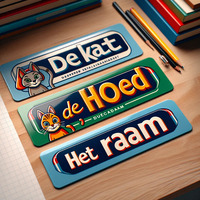Language Learning at Home: the Labeling Game
When you're learning a language, passive learning is often underutilized. What a lot of students and parents of students do is to label things in
their home in the language. For example, if you're learning Dutch, there are a lot of little words like "het raam", "de deur", "de muur", "de la" and
so on to describe a variety of items.

The trick is to strategically place the labels so that it's seen quite often. This helps build an association in the brain, so that it will become automatic to 'feel' the word. It's also fun to do with one's kids, where a word is picked from a bag and you have to find the corresponding item in the house and attach the label to it.
Here's a very quick how-to guid:
- Pick the language: whether it's Spanish, French, Dutch or any other language, it'll be lots of fun.
- Select a number of words. Usually, it's best to stick to the shortest versions. You won't need more than 20 or so in total. In case of a language like Dutch, Spanish, French and so on, it's a good idea to include the article (e.g. de/het, le/la, etc)
- Make the labels. This can be as simple as using some sticky notes, but you can also print them out and have colorful labels. Pro tip: after printing, make sure to laminate the labels to make them extra durable. You can ask TaalTaal for examples of ready-made .pdf files.
- Start labeling: now the fun begins! You can do this in any number of ways. If you're teaching your child, it's nice to do it together and if you're learning yourself, it can be fun to do it with a partner of friend. Make sure to pronounce every word.
- Gradually expand your portfolio of words. Every week or so, you can easily add 5-10 words.
- Play and learn: you can use it actively by doing a treasure hunt, but even if you just leave the labels there and do nothing, your brain will still see them regularly attached to the corresponding object and train the association passively. So you're learning without doing anything!
This simple activity not only boosts vocabulary but also integrates language learning into daily life, making it a natural and enjoyable part of your language learning. And if you're trying to help your child, it's even more valuable because it transforms a 'boring' learning activity into fun quality time.
Locatie en contact
U kunt ons per telefoon bereiken op 070-3226091 of per e-mail via info@taaltaal.nl - wij horen graag van u!Certificaat
U ontvangt na afloop van de cursus een certificaat met uw behaalde niveau. Hiervoor hanteren wij het gestandaardiseerde Europees Referentie Kader (ERK). Hiermee kunt u ook eenvoudig aansluiting vinden tussen verschillende instituten.Totaalpakket
Actueel Onderzoek
Als taleninstituut beschikt TaalTaal over haar eigen onderzoeksafdeling die speciaal is gericht op het ontwikkelen van vernieuwende methodieken zodat u de taal niet alleen intuïtiever aanleert, maar ook beter blijft onthouden en kunt verfijnen. Als TaalTaal-cursist profiteert u van een breed spectrum aan expertise en kennis.Cursus Nederlands | Cursus Spaans | Cursus Italiaans | Cursus Frans | Cursus Engels | Cursus Japans | Cursus Russisch | Kindercursusssen | Intensieve cursus Nederlands | Turbo Nederlands | Nederlands Onderdompeling | Veelgestelde Vragen (F.A.Q.) | TaalTaal Blog | Locaties | De/Het spel


